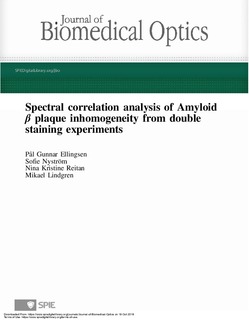Spectral correlation analysis of Amyloid beta plaque inhomogeneity from double staining experiments
Journal article, Peer reviewed
Published version
Permanent lenke
http://hdl.handle.net/11250/2624035Utgivelsesdato
2013Metadata
Vis full innførselSamlinger
- Institutt for fysikk [2698]
- Publikasjoner fra CRIStin - NTNU [38294]
Sammendrag
A spectral correlation algorithm for the analysis of hyperspectral fluorescence images is proposed by Ellingsen et al. [J. Biomed. Opt. 18, 020501 (2013)]. Here, it is applied to the analysis of double-stained Aβ amyloid plaques being related to the Alzheimer’s disease (AD). Sections of APP/PS1 AD mice model brains are double stained with luminescent-conjugated oligothiophenes, known to bind to amyloid protein deposits. Hyperspectral fluorescence images of the brain sections are recorded and by applying the correlation algorithm the spectral inhomogeneity of the double-stained samples is mapped in terms of radial distribution and spectral content. To further investigate the progression of Aβ amyloid plaque formation, 19 AD mice of different ages up to 23 months are characterized, enabling a statistical analysis of the plaque heterogeneity. In accordance with recent findings by Nyström et al. [ACS Chem. Biol. 8, 1128–1133 (2013)], the spectral distribution within Aβ plaques is found to vary with age throughout the lifespan of the mouse. With the new correlation algorithm, it is possible to quantify the spectral abundance of the two stains depending on the relative distance from the plaque center and mouse age. Thus, we demonstrate the use of the correlation analysis approach in double-staining experiments and how it is possible to relate these to structural/spectral changes in biological samples. Spectral correlation analysis of Amyloid beta plaque inhomogeneity from double staining experiments
